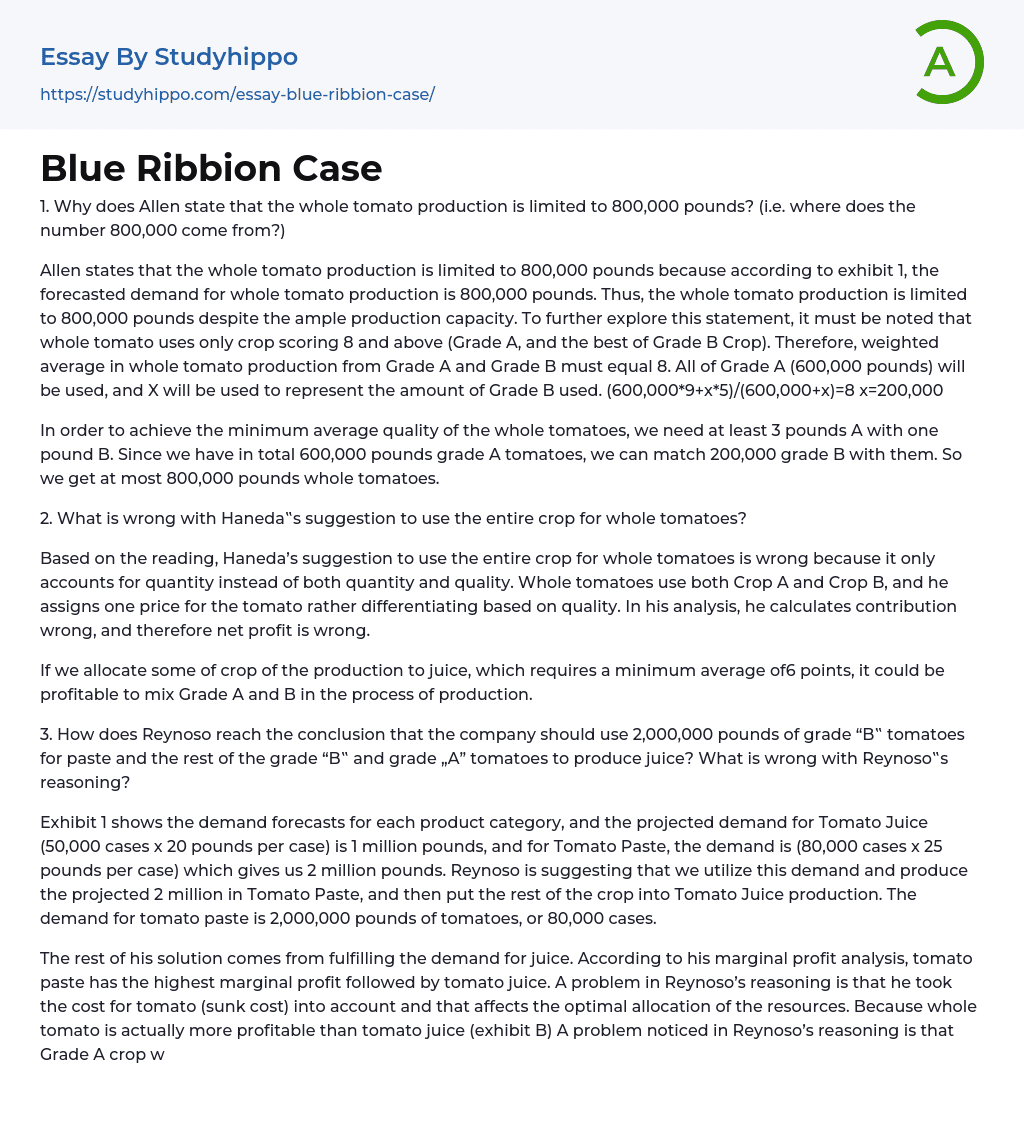Allen states that the total quantity of tomato production is represented by the number 800,000.
According to Allen, the demand for whole tomato production is projected to be 800,000 pounds. Consequently, despite having enough production capacity, the total production of whole tomatoes is limited to 800,000 pounds. To better understand this statement, it's important to note that only tomatoes with a crop scoring of 8 or higher (Grade A or the best of Grade B crop) are used for whole tomato production. Therefore, in order to achieve an average score of 8 for Grade A and Grade B tomatoes used in whole tomato production, the entire amount of Grade A tomatoes which is 600,000 pounds will be utilized while X represents the quantity of Grade B tomatoes used. The formula for calculating this wei
...ghted average is (600,000 * 9 + X * 5) / (600,000 + X) = 8. By solving this equation we find that X equals to 200,000 pounds.
In order to achieve the lowest average quality among all tomatoes, it is necessary to have a minimum combination of 3 pounds of grade A tomatoes and 1 pound of grade B tomatoes. Our available supply consists of 600,000 pounds of grade A tomatoes and 200,000 pounds of grade B tomatoes. This gives us the opportunity to obtain a maximum quantity of 800,000 pounds in total for whole tomatoes.
What is the issue with Haneda's proposal to utilize the entire crop for whole tomatoes?
According to the reading, Haneda's proposal to utilize the complete crop for whole tomatoes is incorrect since it only considers quantity and not quality
Whole tomatoes are produced from Crop A and Crop B, but Haneda assigns one price for all tomatoes without taking into account their varying quality. Additionally, Haneda calculates the contribution incorrectly in his analysis, leading to an inaccurate net profit calculation.
If we assign some of the crop production to juice, which needs a minimum average of 6 points, it may be worthwhile to blend Grade A and B during the production process.
3. What reasoning does Reynoso use to determine that the company should utilize 2,000,000 pounds of grade "B" tomatoes for paste and the remaining grade "B" and grade "A" tomatoes for juice? What is the flaw in Reynoso's logic?
The demand forecasts for different product categories are shown in Exhibit 1. Tomato Juice is expected to have a demand of 1 million pounds (50,000 cases x 20 pounds per case), while Tomato Paste is anticipated to have a demand of 2 million pounds (80,000 cases x 25 pounds per case). Reynoso suggests taking advantage of this demand by producing the estimated quantity of Tomato Paste and using the remaining harvest for Tomato Juice production. The demand for tomato paste requires 2,000,000 pounds of tomatoes or 80,000 cases.
Fulfilling the demand for juice contributes to the rest of his solution. According to his analysis of marginal profit, tomato paste has the highest marginal profit, followed by tomato juice. However, Reynoso's reasoning has a flaw when he considers the cost of tomato (sunk cost), which affects resource allocation optimization. This is because whole tomato is actually more profitable than tomato juice (exhibit B). Another issue observed in Reynoso's reasoning
is that Grade A crop becomes a sunk cost as it is already purchased. If they use crop A for juice production, which requires a minimum of 6 points, it increases the product's cost and reduces the juice's profit. Ultimately, Reynoso is utilizing unnecessarily expensive raw materials.
- Food Safety essays
- Food Security essays
- Beverages essays
- Cuisines essays
- Dairy essays
- Desserts essays
- Fast Food essays
- Bread essays
- Meal essays
- Meat essays
- Organic Food essays
- Rice essays
- Sugar essays
- Taste essays
- Beef essays
- Coconut essays
- Crowd essays
- Dinner essays
- Juice essays
- Sainsbury essays
- Cooking essays
- Ginger essays
- Oreo essays
- Drink essays
- Beer essays
- Wine essays
- Coffee essays
- Tea essays
- Cake essays
- Hamburger essays
- Ice Cream essays
- Burger essays
- Pizza essays
- Fruit essays
- Lemon essays
- Food Waste essays
- Favorite Food essays
- Alcoholic essays
- Soft Drinks essays
- Cookie essays
- Starch essays
- Yeast essays
- Cola essays
- Pizza Hut essays
- snack foods essays
- chips essays
- Biscuit essays
- Brewing essays
- Brewery essays
- John Locke essays




